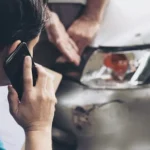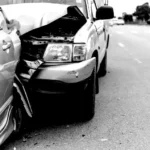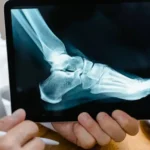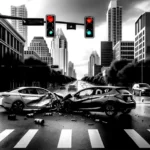Car accident victims that are left with injuries are often left with enormous medical expenses, on top of their pain and suffering. Car accident attorney Beverly R. Caruthers understands how difficult these situations can be. Not only are you dealing with you car accident injuries and trying to find proper medical care, you also have to navigate the process of filing a car accident claim and proving fault.
Our law office will evaluate your case with zero obligation or cost to you, regardless of what kind of auto accident you have been through. This includes truck accidents, and all other motor vehicle collisions. We help you file a claim and will communicate with insurance adjusters on your behalf to ensure you are protecting yourself against their predatory tactics. If you have been involved in a car accident in Houston, call us today for your free case evaluation.
Establishing Fault for Rear-End Accidents
Every driver on the road has a duty to follow other vehicles at a safe distance that varies depending on vehicle speed, road conditions, and a whole host of other factors. Drivers who breach (violate) this duty are negligent. That’s why, in a rear-end accident, the trailing driver who rear-ends the lead vehicle will almost always be found at least partially negligent (at fault for the accident).
But it’s possible for the driver of the car that gets rear-ended to be negligent too, including when:
- the lead driver suddenly goes into reverse
- the lead car’s brake lights don’t work properly
- the lead driver suddenly hits the brakes for no valid reason (“brake checks”) the trailing driver, or
- the lead car has a mechanical problem, but the lead driver doesn’t move it fully to the side of the road.
So, what happens when trailing and lead drivers share fault for an accident? The rules vary from state to state based on contributory and comparative negligence laws.
Car Accidents and the Concept of Negligence
Negligence is the term used to describe behavior that hurts others and falls below a basic standard of care. Basically, you are negligent if you don’t act in a reasonable way, and someone is injured as a result. What constitutes reasonable behavior depends on the circumstances surrounding the accident.
To prove that a car accident was caused by driver negligence, you must first show that the driver had a duty of care. This is pretty simple because all drivers owe a duty to other people on the road to not do something that might cause an accident.
Second, you must show that the other driver breached this duty. Drivers in rear-end collisions can breach their duty of reasonable care in a number of ways, including failing to:
- pay attention to the road and look out for hazards
- stop within a reasonable time
- drive at a reasonable speed based on the weather and road conditions
- maintain control of their vehicle
- yield the right of way
- use turn signals, and
- follow at a safe distance.
Third, you must prove the other driver’s breach of duty was the cause of the accident. Finally, you must establish that you suffered damages as a result of the accident. This includes car accident injuries and vehicle damage.
This is fairly simple in theory, especially when it’s easy to identify the at-fault driver. But what happens when the negligence of two or more drivers caused the accident?
Comparative Negligence vs. Contributory Negligence
If more than one driver is at fault for a car accident, the outcome will vary from state to state. A few states still follow a fairly harsh “contributory negligence” system, but most have adopted “comparative negligence” rules. Let’s take a look at the difference between the two.
Contributory Negligence
Only a handful of states still subscribe to this system. Essentially, under the law of contributory negligence, if Driver A can show that Driver B’s negligence contributed to the accident to any degree, Driver B can’t recover anything at all in a lawsuit against Driver B. So if Driver B was 1% at fault for the accident, they get nothing from Driver A, even if Driver A was 99% at fault.
Comparative Negligence
Comparative negligence allocates fault between drivers. A driver’s liability may be reduced, but not necessarily eliminated, if the other driver is partly at fault for the accident. There are two variations of the comparative negligence system:
- Pure comparative negligence: Liability gets split according to the percentage of each driver’s fault. So, if Driver A is 30% to blame for a car accident, and she has $10,000 in damages, she can only collect $7,000 from Driver B (who was 70% to blame for the accident.)
- Modified comparative negligence: Liability gets split according to the percentage of fault, to a certain level. Once a plaintiff meets or exceeds that level, the plaintiff is barred from recovery. That limit is typically 50% or 51%. In other words, if a plaintiff is more than 50% at fault for the accident, the plaintiff is barred from recovering anything at all from the other at-fault drivers.
These shared fault rules will apply in the event that your car accident lawsuit goes all the way to trial, but insurance adjusters also keep these principles in mind when negotiating a settlement after a car accident.
Getting Compensation After a Rear-End Accident
In most rear-end collisions, the driver of the tail vehicle will be legally responsible for paying for the lead driver’s monetary damages. The repair costs for the lead vehicle are typically easy to calculate, so many car insurance companies are quick to pay for those costs. But a complication often arises when it comes to paying for the lead driver’s medical bills. That’s because common personal injuries from rear-end collisions are back and whiplash injuries, which are often hard to quantify, as they don’t always show up on diagnostic exams.
Next Steps After a Rear-End Collision
It might seem like identifying the at-fault driver is obvious after a rear-end crash, but there could be small details that can completely shift the liability picture. Even if fault for the accident is no longer in question, the issue of how much you may owe in damages might be in dispute, especially when you and the other driver share blame for the accident.
A car accident lawyer can answer your questions and help you with all phases of a car insurance claim or lawsuit process, including proving fault. Learn more about hiring and working with a lawyer. You can also connect with a lawyer directly from this page for free.
Spanish Speaking Car Accident Lawyer in Houston, Texas
Spanish-speaking individuals can have a more difficult time seeking justice in their personal injury cases due to language barriers. This causes them to not take action against those who have left them with financial devastation and physical trauma. At the Law Office of Beverly R. Caruthers, our team refuses to let a language barrier affect your right to justice and compensation. If you or someone you love has been injured in an accident and is in need of Spanish-speaking legal advice, our team is here for you.
Personal Injury Lawyer in Houston, Texas
If you or someone you love has been involved in a car accident and suffered an injury, experienced loss of income, or are unable to work due to a car accident, you can benefit from the services of a Houston car accident expert in your personal injury case. Whether you missed work due to an injury or due to not having access to a vehicle, Attorney Beverly R. Caruthers can help you!
Caruthers Law Firm
Address: 4141 Southwest Fwy, Suite 400
Houston, TX 77027
(713) 526-9557
View our Website
View our Facebook page
View our Google Listing






